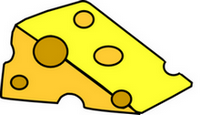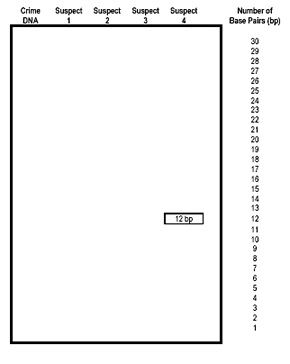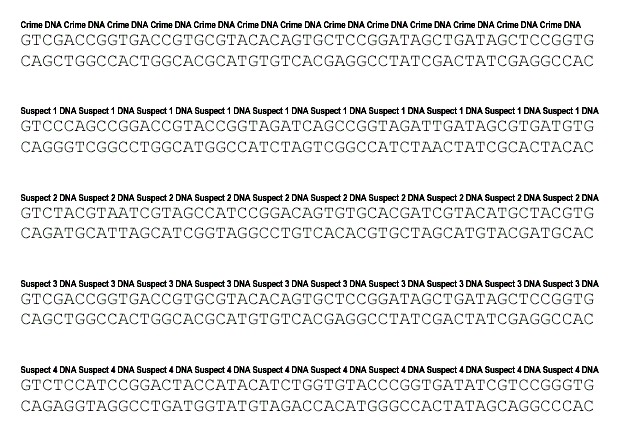 Who Ate the Cheese?!
Who Ate the Cheese?!
Download Google Doc
Objectives: In this simulation you
will examine crime scene evidence to determine who is responsible for eating
the Queen's special imported Lindbergher Cheese (yes, the stinky cheese). You
will model the process of electrophoresis and DNA fingerprinting.
|
ROYAL GUARD INCIDENT REPORT
|
Incident Data
| Incident Type: |
Theft |
|
Complaint Status |
Pending DNA
results |
| Processed by: |
Chief Wiggam |
|
Other Officers: |
Officer Li Gase |
Property
| Property Code: |
Rare cheese |
|
Owner's Name |
Queen Elizabeth |
| Name: |
Lindbergher |
|
Value: |
$12,000 |
Burglary Data
Method of Entry: Unknown, no
evidence of force on doors or windows.
Narrative: The cheese was allegedly
stolen from the Queen's sitting room the night before the grande ball.
The cheese was listed as a gift from the Manchurian diplomat. Officer
Li Gase dusted for fingerprints and found none on the table or doors,
the maid claimed that they had been wiped clean earlier. The wheel of
cheese was on a platform in the sitting room, and half of it had been
eaten. We took pictures of the half eaten cheese and sent it to the lab
for further tests. Edna N. Zime, the lab technician said that saliva samples
could be taken from the teeth imprints of the cheese that was left behind.
Suspect Data
Suspect Number: 1
Name: Princess Dubbah Elix
Description of Suspicion: The princess was seen entering the sitting room
earlier in the evening. She is well known for her love of cheese.
Suspect Number 2
Name: Electra Foresis
Description of Suspicion: Electra was recently involved in a relationship
with the Manchurian diplomat that sources say ended badly. Her motive
may have been to sabotage the diplomat's gift to the Queen.
Suspect Number 3
Name: Ada Nine
Description of Suspicion: Ada was the maid in charge of cleaning the sitting
room. She had access to the cheese.
Suspect Number 4
Name: Gene Tics
Description of Suspicion: Gene is the leader of the local Cheese-Makers
Guild, he may not have wished for Queen Elizabeth to have cheese from
anywhere but his own guild.
Crime Lab Data
| Crime Lab Investigator |
R. Renee |
|
Lab Technician |
Edna N. Zime |
| List of Evidence
Received |
Plastic bag
with cheese crumbs |
|
List of Procedures
Used |
DNA extraction
Polymerase Chain Reaction
DNA restriction Analysis |
Narrative: After receiving the
package with the plastic bag marked Crime Scene, the DNA was extracted.
Because the sample was so small, the DNA was amplified using the polymerase
chain reaction. We isolated the DNA from the four suspects and compared
them to the crime scene DNA using DNA restriction analysis.
Results: See attached DNA Results
|
DNA Evidence Evaluation
1. Turn your paper strips (DNA sequences)
so that the side with the bases is facing you. The restriction enzyme cuts at
each point it finds C C G G, always cutting between the C and the G. Label the
back of the slips with the suspect number so that you don't get them confused
after cutting. Use scissors to cut the DNA sequence at the C C G G points.
2. Count the number of base pairs (bp)
in each piece of DNA that you created. Record the base pair number on the back
side of the DNA fragment.
3. Make an enlarged chart like the
one shown. Your teacher will give you paper for this. Use a ruler to ensure
that the lengths are uniform. Alternatively, you can use chalk markers on the lab desk.
4. Tape your DNA fragments to the chart,
using the base pair numbers as a guideline for fragment placement.
5. Compare the crime scene DNA to the
suspects and indicate on your chart, which suspect is guilty of eating the cheese. |
 |

1. On your chart, label the positive
(+) and the negative (-) ends. Circle the suspect's DNA who matches the DNA
at the crime scene and write the name of the suspect.
Who ate the cheese? ___________________________________________
How do you know? _________________________________________________
2. For each of the following tasks
performed in the activity, describe what they are actually simulating.
Cutting the DNA into fragments: ________________________________________________________
Taping the DNA onto the large paper:
_____________________________________________________
3. For each word below, describe how
it relates to DNA Fingerprinting:
Polymerase Chain Reaction __________________________________________________________________
Gel Electrophoresis ________________________________________________________________________
Restriction Enzyme _________________________________________________________________________
 Who Ate the Cheese?!
Who Ate the Cheese?! 


